Businesses in the real estate activities sector
Data extracted in February 2023
Planned article update: 27 June 2024
Highlights
The real estate activities sector accounted for 1.9 % of the total employment in the EU in 2020.

(% share of sectoral employment)
Source: Eurostat (sbs_sc_ind_r2)
This article presents an overview of statistics for the European Union's (EU) real estate sector, as covered by NACE Rev. 2 Section L. Real estate services are provided to households and to business clients. The use of renting in relation to property can increase financial flexibility, reducing the need to commit own capital. It belongs to a set of statistical articles on 'Business economy by sector'.
Full article
Structural profile
The EU's real estate activities (Section L) numbered over 1.3 million enterprises in 2020, 2.0 % more than in 2019, employing 2.5 million persons, a small drop of 2.7 % compared with the pre-COVID-19 pandemic times. The real estate activities sector generated €247 billion of value added in 2020, a 3.3 % decrease compared with the previous year. In 2020, this sector's contribution to the non-financial business economy (Sections B to J and L to N and Division 95) was 5.8 % of the enterprise population, 1.9 % of the employment, and 3.8 % of value added.
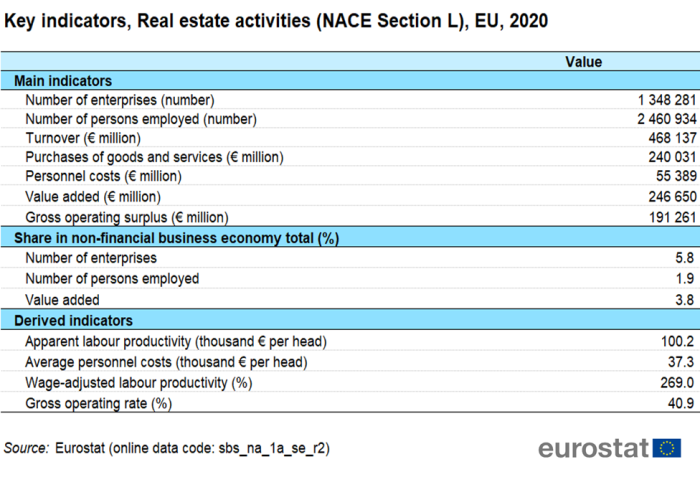
Source: Eurostat (sbs_na_1a_se_r2)
The apparent labour productivity of the EU's real estate activities sector in 2020 was €100 200 per person employed, which was almost twice as the non-financial business economy average of €50 900 per person employed and second highest among the NACE sections that form the non-financial business economy.
The wage-adjusted labour productivity ratio shows that value added per person employed was equivalent to 269.0 % of average personnel costs per employee across the EU in 2020. This ratio was almost double the non-financial business economy average (139.8 %) and second highest among the NACE sections that form the non-financial business economy. The EU's real estate activities sector recorded a gross operating rate of 40.9 % in 2020, four times the 10.2 % average for the whole of the non-financial business economy.
Sectoral analysis
The largest subsector within the EU's real estate activities sector in 2020 was renting and operating of own or leased real estate (Group 68.2), which accounted for almost three-quarters (71.6 %) of sectoral value added and contributed to more than a half (53.3 %) of the employment. The second largest subsector was real estate activities on a fee or contract basis (Group 68.3) which contributed one-fifth (20.87 %) of value added and almost twice this share (39.0 %) to the employment for real estate activities. The smallest subsector was buying and selling of own real estate (Group 68.1) with a 7.7 % share of the real estate activities employment and 7.6 % of value added.

(% share of sectoral total)
Source: Eurostat (sbs_na_1a_se_r2)
The high wage-adjusted labour productivity ratio recorded for the EU's real estate activities sector in 2020 was pulled up by the ratios recorded for renting and operating of own or leased real estate (351.9 %) and for buying and selling of own real estate subsector (302.7 %), while the ratio recorded for real estate activities on a fee or contract basis (144.4 %) was in line with the non-financial business economy average (139.8 %). Similar results were recorded for the gross operating rate, where indicators for real estate activities on a fee or contract basis (25.7 %) were considerably lower than for the renting and operating of own or leased real estate (48.7 %).
Average personnel costs within the real estate activities sector were €38 200 per employee for renting and operating of own or leased real estate, €36 800 per employee for real estate activities on a fee or contract basis and €33 400 per employee for buying and selling of own real estate, which were close to the average for the non-financial business economy (€36 400 per employee).

Source: Eurostat (sbs_na_1a_se_r2)

Source: Eurostat (sbs_na_1a_se_r2)
Country overview
Germany had by far the highest value added for real estate activities in 2020 among the EU Member States, generating 26.7 % of the EU total, followed by France (14.8 %), while in third to fifth place were Denmark, the Netherlands and Sweden, with approximately the same shares 8.6 %, 7.5 % and 7.4 % respectively.
Highest specialised country in sector (in value added terms) was Denmark, where real estate activities accounted for 12.6 % of their non-financial business economy value added in 2020, mainly because of strong specialisation in renting and operating of own or leased real estate, where it recorded 11.0 % of their non-financial business economy value added in 2020. It was followed up by Estonia (6.9 %), while in value added terms, the least specialised EU Member State was Ireland, where real estate activities accounted for less than 1.0 % of non-financial business economy value added. Among the non-EU countries, Norway and Iceland reported a relatively high degree of specialisation in this sector, as real estate activities provided 6.0 % and 7.8 % respectively of the value added that was generated within non-financial business economy in 2020.
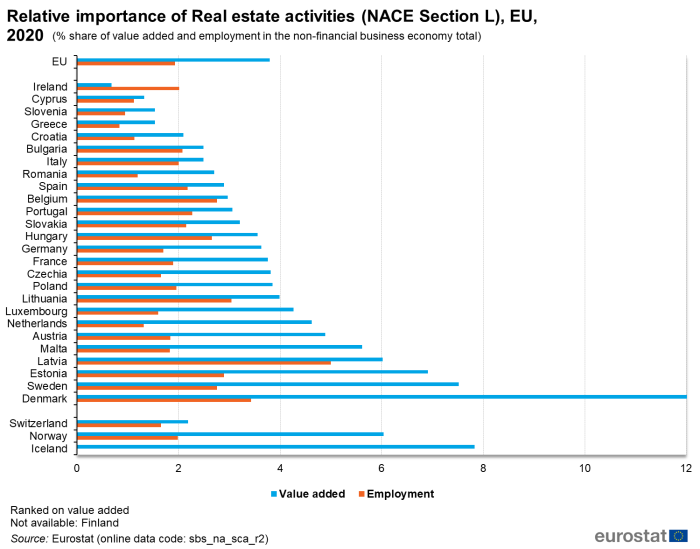
(% share of value added and employment in the non-financial business economy total)
Source: Eurostat (sbs_na_sca_r2)
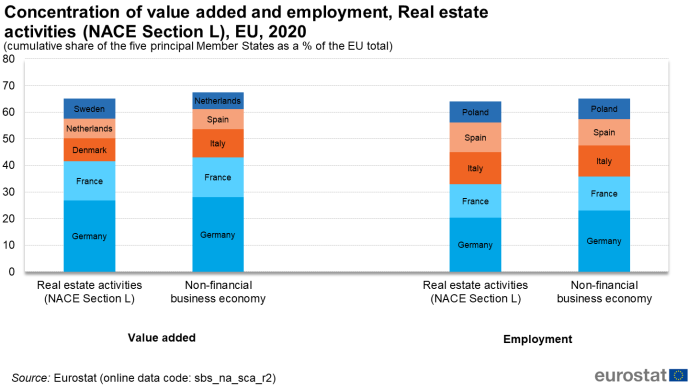
(cumulative share of the five principal Member States as a % of the EU total)
Source: Eurostat (sbs_na_sca_r2)
Germany had the greatest value added for all three activities in the sector: buying and selling of own real estate (€4.8 billion or 2.0 % of the EU total), renting and operating of own or leased real estate (€44.7 billion or 18.1 % of the EU total) and in the real estate activities on a fee or contract basis subsector (€16.5 billion or 6.7 % of the EU total).
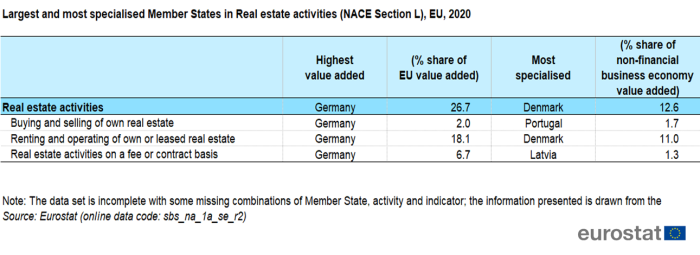
Source: Eurostat (sbs_na_1a_se_r2)
Wage-adjusted labour productivity ratios for the real estate activities sector were very high in nearly all of the EU Member States in 2020, with only Spain (159.9 %), Ireland (168.0 %), Portugal (185.6 %), Italy (186.9 %), Bulgaria (194.1 %) and Belgium (195.1 %) recording ratios below 200 % (which indicates that apparent labour productivity was at least twice as high as average personnel costs). By far the highest wage-adjusted labour productivity ratios for real estate activities were recorded in Denmark (636.4 %) and Malta (497.7 %).
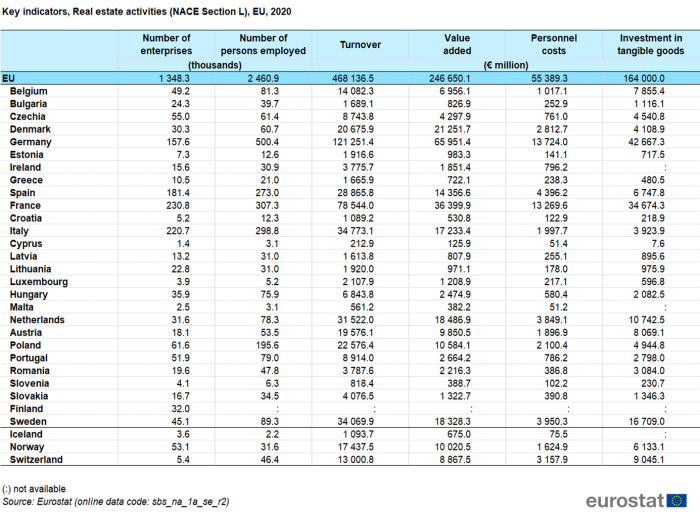
Source: Eurostat (sbs_na_1a_se_r2)
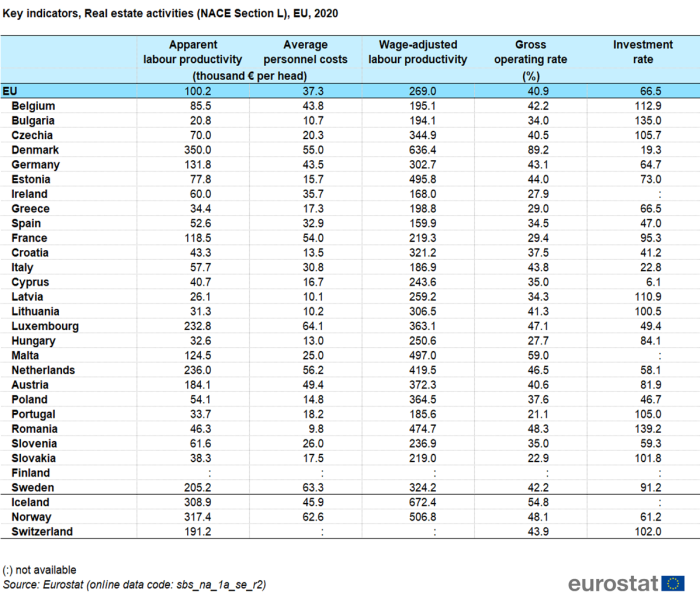
Source: Eurostat (sbs_na_1a_se_r2)
Size class analysis
The vast majority of the enterprises that were active in the EU real estate activities sector in 2020 were classified as micro enterprises (employing less than 10 persons). These micro enterprises dominated the real estate activities sector as they accounted for 98.1 % of the total number of enterprises in the real estate activities sector, while providing employment to the majority (63.7 %) of the real estate activities employment and also generating more than half (51.8 %) of the added value. Indeed, micro enterprises within the real estate activities sector recorded the highest contribution to sectoral value added and to sectoral employment across any of the NACE sections that compose the non-financial business economy.
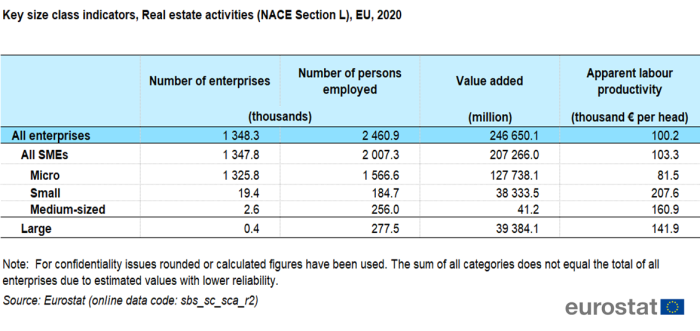
Source: Eurostat (sbs_sc_sca_r2)
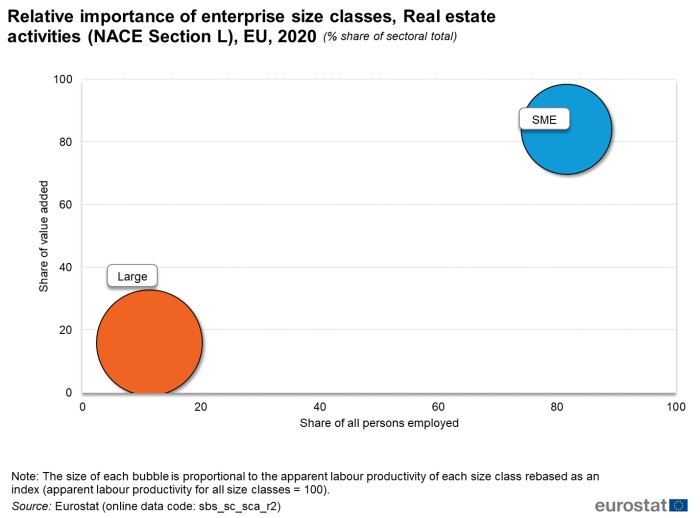
(% share of sectoral total)
Source: Eurostat (sbs_sc_sca_r2)
This pattern was repeated in all subsectors, with the contribution of micro enterprises at around half or more to both value added and employment.

(% share of sectoral employment)
Source: Eurostat (sbs_sc_ind_r2)
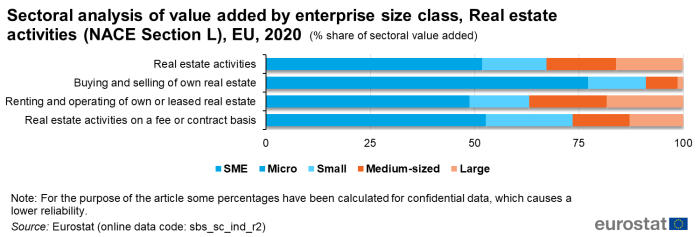
(% share of sectoral value added)
Source: Eurostat (sbs_sc_ind_r2)
Across most of the EU Member States, micro enterprises frequently accounted for more than half of the total number of persons employed in the real estate activities sector in 2020, peaking at 93.2 % of the total employment in Italy and 87.1 % in Portugal. By contrast, the Netherlands, France, Denmark and Sweden reported that less than half of those employed in the real estate activities sector worked for micro enterprises.
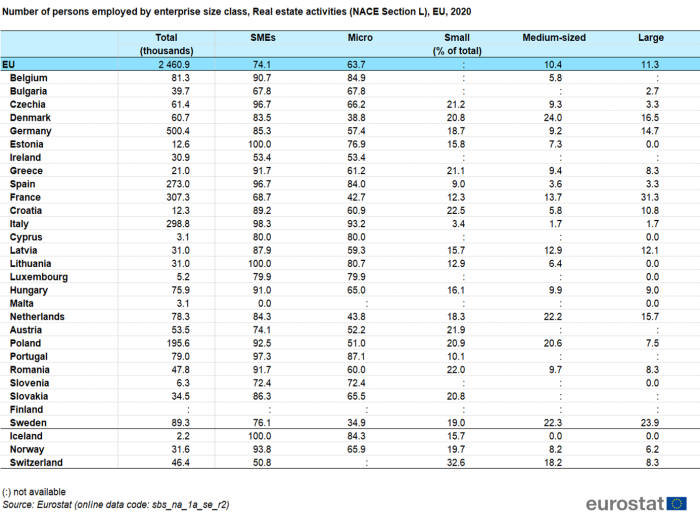
Source: Eurostat (sbs_sc_1b_se_r2)
In terms of value added, the relative importance of micro enterprises was even higher (than for employment). For example, micro enterprises accounted for more than a 75 % of total value added in seven countries, while this share was lower than one-third in only two countries: the Netherlands (30.1 %) and Sweden (25.9 %).
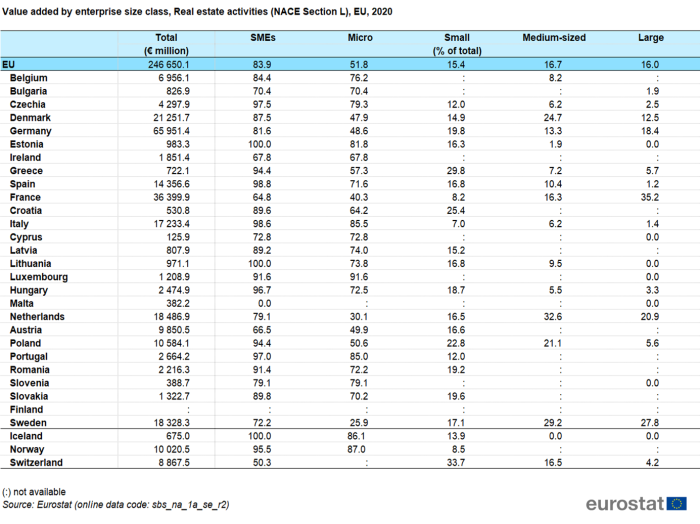
Source: Eurostat (sbs_sc_1b_se_r2)
Regions
The French capital city region of Île de France and the Italian region of Lombardia (which includes the city of Milan) recorded the highest number of persons employed, across NUTS level 2 regions within the EU for the real estate activities sector in 2020. With 112 900 persons, Île de France accounted for almost 5 % of the total number of persons employed in the EU in this sector. It was followed by the region of Cataluña in Spain (which includes Barcelona) with a share of 2.9 %. The third highest number of persons employed was recorded for Comunidad de Madrid, also in Spain, where around 59 200 persons worked in the real estate activities sector. The capital city region of Poland, Warszawski stołeczny and the German region Düsseldorf completed the ranking of the top five regions in relation to employment levels within the real estate activities sector.
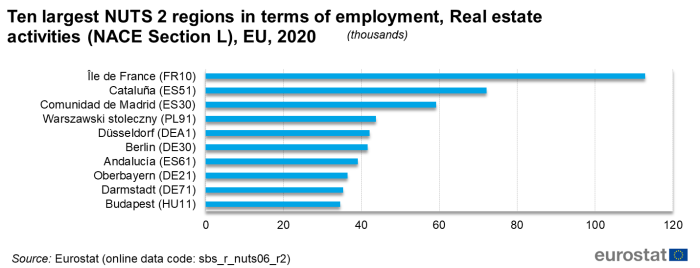
(thousands)
Source: Eurostat (sbs_r_nuts06_r2)
The ranking of the largest regions (in employment terms) suggests that the EU's real estate activities sector was particularly developed in Germany (6 regions), Spain (4 regions) and France (3 regions). Besides them, Poland (2 regions) also employed the large number of persons in the real estate activities sector. The other regions with high levels of employment in the real estate activities sector included Latvia (which is a single NUTS level 2 region) and the capital region from each of the following countries: Hungary (Budapest), Portugal (Área Metropolitana de Lisboa), Czechia (Praha) and Sweden (Stockholm).
Data sources
Coverage
Real estate activities are divided into three separate NACE groups and include:
- buying and selling own real estate (Group 68.1);
- renting (to third parties) and operating own or leased residential and non-residential real estate, including both furnished and unfurnished property; the development of building projects for own operation is also included (Group 68.2);
- appraising real estate; providing real estate agency services as an intermediary; managing property as an agent (Group 68.3).
Real estate activities do not include facilities management which is considered part of administrative and support services (Section M), nor the development of building projects for later sale which is part of construction (Section F), nor short-stay letting of accommodation (for example, for holiday purposes) which is part of accommodation and food services (Section I).
Data sources
The analysis presented in this article is based on the main dataset for structural business statistics (SBS), size class data and regional data, all of which are published annually.
The main series provides information for each EU Member State as well as a number of non-EU countries at a detailed level according to the activity classification NACE. Data are available for a wide range of variables.
In structural business statistics, size classes are generally defined by the number of persons employed. A limited set of the standard structural business statistics variables (for example, the number of enterprises, turnover, persons employed and value added) are analysed by size class, mostly down to the three-digit (group) level of NACE. The main size classes used in this article for presenting the results are:
- small and medium-sized enterprises (SMEs): with 1 to 249 persons employed, further divided into:
- micro enterprises: with less than 10 persons employed;
- small enterprises: with 10 to 49 persons employed;
- medium-sized enterprises: with 50 to 249 persons employed;
- large enterprises: with 250 or more persons employed.
Structural business statistics also include regional data. Regional SBS data are available at NUTS levels 1 and 2 for the EU Member States, Iceland and Norway, mostly down to the two-digit (division) level of NACE. The main variable analysed in this article is the number of persons employed. The type of statistical unit used for regional SBS data is normally the local unit, which is an enterprise or part of an enterprise situated in a geographically identified place. Local units are classified into sectors (by NACE) normally according to their own main activity, but in some EU Member States the activity code is assigned on the basis of the principal activity of the enterprise to which the local unit belongs. The main SBS data series are presented at national level only, and for this national data the statistical unit is the enterprise. It is possible for the principal activity of a local unit to differ from that of the enterprise to which it belongs. Hence, national SBS data from the main series are not necessarily directly comparable with national aggregates compiled from regional SBS.
Context
The services of real estate activities are very diverse: real estate agents let (rent) or sell on a commission basis; traders buy and sell property; valuers, facilities and estate managers provide professional services; and finally owners let property. Most of these activities are related to the secondary market concerned with existing property, although some, such as property developers for own operation are active in the primary market and are therefore closely related to the construction sector.
Real estate activities have very different cost structures and revenue streams. As such, care has to be taken when comparing them, particularly when trying to measure the size of each subsector or their use of capital or labour. In particular, when enterprises are the owner of a good that they rent or lease, their financial costs and depreciation charges may constitute the main element of their total costs, but these are not considered when calculating gross value added or indicators of productivity based on this.
As regards the policy context of the real estate activities, this sector crosses a number of important areas, including — among others — the internal market, consumer protection, the energy performance of buildings and taxation.
The Services Directive seeks to remove legal and administrative barriers to trade. From the perspective of property professionals the principles of the freedom of establishment and free movement of services permit real estate agents and other professionals to offer their services outside their country of origin. From a consumer perspective the opening up of the internal market has been achieved while at the same time ensuring that sufficient safeguards are in place to protect consumers (for example, timeshare arrangements or alternative dispute resolution, which makes it easier for consumers to have complaints and problems dealt with without going to court).
Direct access to
- SBS – services (sbs_serv)
- Annual detailed enterprise statistics - services (sbs_na_serv)
- Annual detailed enterprise statistics for services (NACE Rev. 2 H-N and S95) (sbs_na_1a_se_r2)
- SMEs - Annual enterprise statistics by size class - services (sbs_sc_sc)
- Services by employment size class (NACE Rev. 2 H-N and S95) (sbs_sc_1b_se_r2)
- Annual detailed enterprise statistics - services (sbs_na_serv)
- SBS - regional data - all activities (sbs_r)
- SBS data by NUTS 2 regions and NACE Rev. 2 (from 2008 onwards) (sbs_r_nuts06_r2)
- Decision 1578/2007/EC of 11 December 2007 on the Community Statistical Programme 2008 to 2012
- Summaries of EU legislation: Business statistics
- Regulation (EC) No 295/2008 of 11 March 2008 concerning structural business statistics